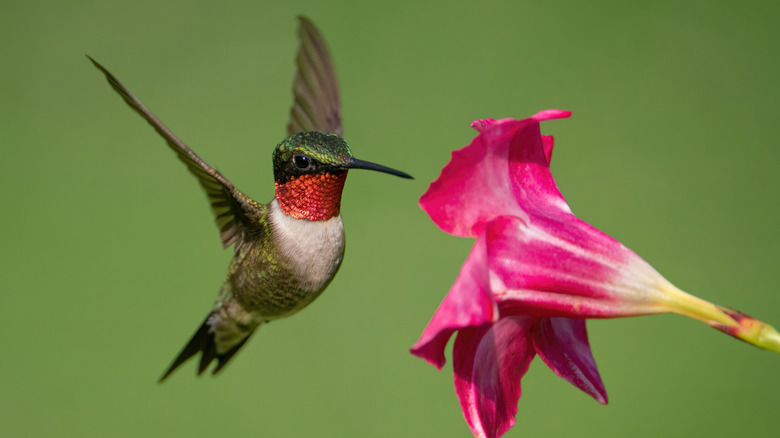The One Type Of Hummingbird You'll Only Find East Of The Mississippi River
Due to their tiny size and fascinating feeding behaviors, hummingbirds are some of the most popular birds in the United States. These birds are only found in the western hemisphere, and there are 366 known species that live between North and South America. Among some of the more common species in North America are the blue-throated, broad-billed, and buff-bellied hummingbirds, just to name a few. Yet, there's only one type of hummingbird that residents in the eastern U.S. may come across: the ruby-throated hummingbird (Archilochus colubris).
Named for the ruby-red throat coloring in male species, the ruby-throated hummingbird is also white, green, black, and tan. This is the only species you may see around your home if you happen to live east of the Mississippi River. Both the eastern U.S. and southern Canada are home to this particular bird during breeding season, when they thrive in wooded and forested areas and gardens. In the U.S., this includes portions of Texas to Florida, as well as the eastern plains, Southeast, mid-Atlantic, and Northeast. During the non-breeding season, some ruby-throated hummingbirds travel to parts of Central America, and they can fly over the Gulf of Mexico by themselves for up to 20 hours at a time. Others may prefer to stay in the southern tip of Florida, or along the Gulf and southern Atlantic coastal areas during the fall and winter months.
How to attract ruby-throated hummingbirds to your yard or garden
Despite their wide presence in the eastern U.S., ruby-throated hummingbirds may not automatically visit your yard or garden. You may need to offer some incentives. First, you can consider offering food. Ruby-throated hummingbirds eat a varied diet of nectar, small spiders, and tiny insects such as fruit flies and mosquitoes. You can help supply them with a feeder filled with homemade hummingbird nectar that is surprisingly easy to make. However, migrating ruby-throated hummingbirds are even more likely to visit your yard if you have certain nectar-producing flowers, especially if they're tubular. As a bonus, these flowers can also attract some of the insects these birds eat, potentially increasing the food options around your property. Most hummingbirds feed from between 1,000 and 2,000 flowers every day, so planting native, nectar-producing plants in your garden can be of great benefit for attracting ruby-throated hummingbirds during spring migration.
It's also important to offer these birds water, but a typical birdbath is not the right choice. Instead, you can place a misting water bath or sprinkler in your yard for the birds to quickly fly through and catch a few drops. Finally, you can help make your yard a hummingbird nest-friendly habitat by leaving certain materials alone that they might want to use. Ruby-throated hummingbirds build their nests with a combination of spider webs, leaves, grass, and plant fibers. Also, since ruby-throated hummingbirds prefer woodlands, you may be more likely to see them flocking around gardens that are near trees, as this also provides them with easy access to build nests on branches.

